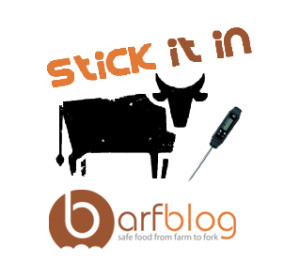There was this time, about five years ago, when the U.S. Department of Agriculture decided to consult with everyone they could find to chat about food safety messaging.
 I participated in good faith, but soon dropped out, because it was apparent the folks in charge had their minds made up, and my – and dozens of others – time on the phone was a consultative circle jerk.
I participated in good faith, but soon dropped out, because it was apparent the folks in charge had their minds made up, and my – and dozens of others – time on the phone was a consultative circle jerk.
The result was those embarrassing Ad Council ads with a pig in a sauna.
I was vocal, saying that cook, clean, chill, separate places too much blame on the consumer and doesn’t account for choosing safety: source food from verifiable safe sources.
Nope, weren’t having any of that, even though the World Health Organization has been promoting that message for 15 years (one of my former students worked on this, years ago).
On World Health Day 2015, WHO/Europe estimates that levels of foodborne disease are much higher than currently reported and underlines the need for improved collaboration among sectors to lower the health risks associated with unsafe food.
Our food chain is longer and more complex than ever before, and demographic, cultural, economic and environmental developments – globalized trade, travel and migration, an ageing population, changing consumer trends and habits, new technologies, emergencies, climate change and extreme weather events – are increasing foodborne health risks.
“The fact that we significantly underestimate how many people become ill from chemicals in the food chain and from common microorganisms such as Salmonella and Campylobacter should start alarm bells ringing across the many areas with a stake in our food chain. A failure in food safety at any link in this chain, from the environment, through primary production, processing, transport, trade, catering or in the home, can have significant health and economic consequences,” says Dr Zsuzsanna Jakab, WHO Regional Director for Europe.
 *Contamination from a single source may become widespread and have enormous health and economic consequences. In 2011, for example, an enterohaemorrhagic Escherichia coli (EHEC) outbreak in Germany and France, linked to imported contaminated fenugreek seeds, led to almost 4000 cases of EHEC infection in 16 countries, including more than 900 haemolytic uraemic syndrome (HUS) cases and 55 deaths. The estimated loss for farmers and industries was US$ 1.3 billion.
*Contamination from a single source may become widespread and have enormous health and economic consequences. In 2011, for example, an enterohaemorrhagic Escherichia coli (EHEC) outbreak in Germany and France, linked to imported contaminated fenugreek seeds, led to almost 4000 cases of EHEC infection in 16 countries, including more than 900 haemolytic uraemic syndrome (HUS) cases and 55 deaths. The estimated loss for farmers and industries was US$ 1.3 billion.
*Changes in animal food production are leading to an increase in the emergence and spread of zoonotic diseases. Of 335 emerging infectious disease events in humans between 1940 and 2004, it is estimated that 60% were transmitted from animals and many of these were foodborne.
WHO calls on policy-makers:
*To build and maintain adequate food safety systems and infrastructures, including laboratory capacities and surveillance and reporting systems;
*To respond to and manage food safety risks along the entire food chain, including during emergencies;
*To foster multisectoral collaboration among public health, animal health, agriculture and other sectors for better communication, information sharing and joint action;
*To integrate food safety into broader food policies and programmes (e.g. nutrition and food security);
*To think globally and act locally to ensure that food produced domestically is as safe as possible internationally.
 World Health Day 2015, celebrated on 7 April, is an opportunity to recognize the important food safety role of all those involved in food production, and to strengthen collaboration and coordination among these various areas, in order to prevent, detect and respond to foodborne diseases efficiently and cost-effectively. A kaleidoscope of events is planned across the globe.
World Health Day 2015, celebrated on 7 April, is an opportunity to recognize the important food safety role of all those involved in food production, and to strengthen collaboration and coordination among these various areas, in order to prevent, detect and respond to foodborne diseases efficiently and cost-effectively. A kaleidoscope of events is planned across the globe.
People are also invited to engage through social media and to promote “From farm to plate: make food safe” using the hashtag #safefood.
The World Organisation for Animal Health (OIE) says to be able to meet the demand for milk, eggs and meat and guarantee their safety, it is first of all essential to control pathogens in animals on the farm.
Eliminating or controlling food hazards at source has proved more effective than an approach relying solely on checking the finished product.




 of affairs in microbiological food safety around the world.
of affairs in microbiological food safety around the world. 
 Jorgen Schlundt, director of food safety at WHO,
Jorgen Schlundt, director of food safety at WHO,